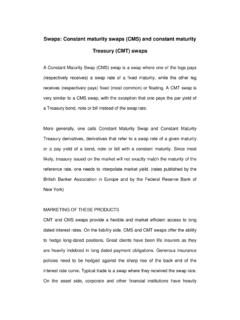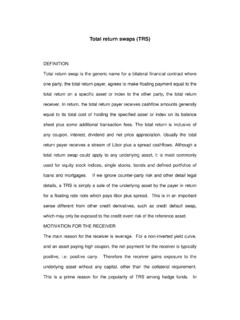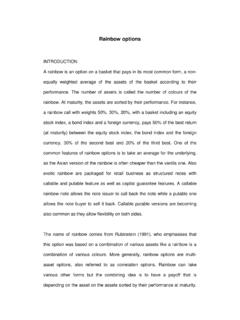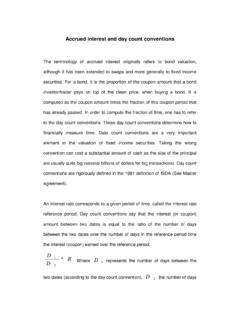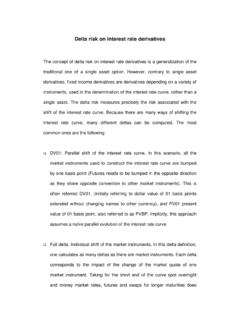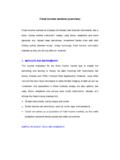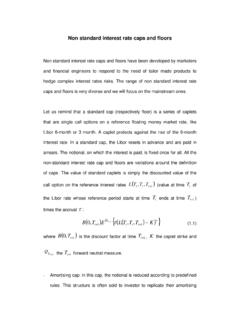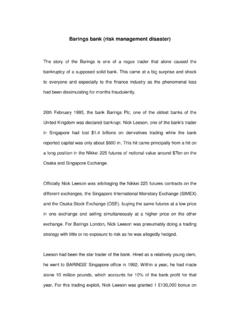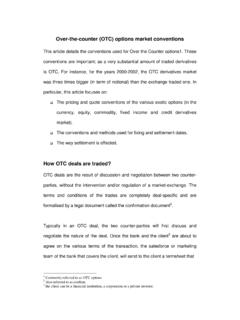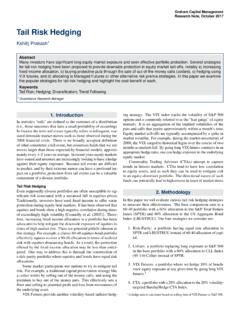Transcription of Forward volatility agreement - Eric Benhamou
1 Forward volatility agreement INTRODUCTION. Forward volatility agreement are Forward contract on the realised1 or the implied volatility (see realised and implied volatility ) of a given equity stock, stock index, commodity index, currency or even interest rates. With the tremendous development of the derivatives market, trading volatility has become a necessity for two reasons: Ability to hedge volatility risk. While it is nowadays relatively easy to hedge the risk of derivatives position against the market move of the underlying(s)2, hedging an option book against volatility (and also correlation) is much harder as there is no liquid market for volatility (and correlation). Ability to speculate on volatility levels. Before the creation of volatility contracts, trader, investors or speculators interested in taking views on future direction of volatility were forced to use options. But options are impure instrument to trade volatility , as the delta component can not be easily (and completely) removed.
2 Delta hedging is at best inaccurate because the real world violates many of the Black-Scholes assumptions. It is quite difficult to estimate accurately the volatility and one needs 1. Although the most common form of Forward volatility contract is the OTC realised Forward volatility contract, contracts on implied volatility are also traded. There is quite a substantial difference between realised and implied volatility . Realised volatility is the historical volatility of a given index while implied volatility is the volatility parameter to be used in the Black Scholes formula to match a given option price. Trading of implied Forward contract is often based on public available implied volatility index such as the VDAX, the VIX or the VNX. Because of the smile problem, implied volatility measure implies in general to quote a volatility for a given strike and maturity, exactly like for an option. 2. Except for very illiquid asset like funds. complicated models to have reasonable delta dynamics, stocks cannot be traded continuously.
3 Transaction costs cannot be ignored and last but not least, markets sometimes jumps and liquidity is often a problem. This market incompleteness has therefore favoured the development of volatility instrument such as Forward volatility contracts, commonly referred to as volatility swap. Other slight variation around volatility swap include variance and covariance swaps. Mathematically defined as the annualised standard deviation of the asset's return during a time window, the realised volatility is a simple measure of the riskiness or uncertainty of a given asset. In contrast, implied volatility is the parameter to be used in the Black Scholes formula to match a given option prices. CONTRACT DESCRIPTION. In a standard Forward volatility contract, the payoff at expiration is given by the difference between the realised or implied volatility3, depending on the contract characteristic, and a volatility level referred to as the strike of the Forward contract N * ( (S ) KVol ) ( ), Where N is the notional of the Forward , (S ) is the reference volatility , and K Vol is the volatility delivery price also referred to as the strike of the Forward contract.
4 Often the volatility is quoted on a 100 basis with three decimals It is important to stress that the volatility referrence has to be clearly specified. In the case of an implied volatility , it is often a public index such as the VOLAX. and VDAX ( implied volatility index on the Dax index using eight option to make a synthetic at-the-money option, published by the Eurex), VIX ( implied volatility index on the 30 days at-the-money OEX options on the S&P 100. futures, published by the CBOE), and NVX ( implied volatility of the Nasdaq 100 index options (NDX), published by CBOE) . In the case of a realized volatility , one needs in particular to specify: The source of data for the volatility computation (Bloomberg or Reuters close, etc). The detail of the computation (standard deviation computed by subtracting the mean, annualisation and normalising factor, etc). implied VERSUS HISTORICAL volatility . Confusing implied and historical can be quite costly for an option book.
5 A. naked option will be in general sensitive to the implied volatility . Vega hedging would aim at hedging this risk. But when delta and gamma hedging a European option, an option trader knows that she is only sensitive to the realised volatility as this affects her breakeven strategy. This is easy to understand. Assume that the Forward underlying Ft of an option has an historical realised volatility of R (F ) . Its dynamics is given by: = R (F )dWt dFt ( ), Ft 3. Realized is the most common form see footnote1. where Wt is a standard Wiener process (see Wiener process). Denoting by O (t , Ft ) a European option with maturity T , one can apply Ito lemma to O (t , Ft )e r (T t ) to get . T. O (T , FT ) = O (t , Ft )e r (T t ) + O (u , Fu )e r (T u ) dFu t F. ( ). T. 2 . 2.. + e r (T u ). O (u , F ) +. 1 2. ( F )F O (u , Fu ) rO (u , Fu ) du t F. u R u 2. t 2 . But if one uses a local volatility model to price this option, one gets that the mark-to-market in this model of the option has to satisfy: 2.
6 2. O (u , Fu ) + m (F )Fu O (u , Fu ) rO (u , Fu ) = 0. 1 2. ( ), t 2 F 2. where m (F ) is a model volatility parameter. The combination of ( ) and ( ) provides that . T. O (T , FT ) = O (t , Ft )e r (T t ). + O (u , Fu )e r (T u ) dFu t F. ( ), 1 2 2. [ . ]. T. + e r (T u ). O (u , Fu ) R (F ) m (F ) du 2 2. Fu t 2 F 2.. which states that the option can be replicated by a long position of O (t , Ft ) in . a risk free asset and holding O (u , Fu ) futures contracts plus an extra pnl F. whose expression is given by the difference between the realised volatility and the model volatility used to hedge. PRICING OF VOLATILTY CONTRACT. Although options traders always mention volatility as the key parameter for pricing option, it is really the variance ( volatility square) that matters for pricing. Moreover, variance contracts are much easier to value than volatility swap as they can be easily statically replicated with a set of options (see below).
7 Therefore, before examining the pricing of Forward volatility contract, we will first study the one of a variance swap, defined as: (. N * 2 (S ) K Var ) ( ), with the same notation as in equation ( ). We know that by default the Forward dynamic of a given asset is a martingale under the Forward neutral measure. If we decide to write this assumption using a lognormal model, we get = R (F )dWt dFt l ( ), Ft where R (F ) represents the lognormal equivalent realised volatility , while l using a normal assumption would lead to dFt = R (F )dWt n ( ), with similarly R (F ) the normal equivalent realised volatility4. n Using once again Ito lemma leads to see that for any smooth5 function g (Ft ) , we have under hypothesis ( ): . [2 . ]. T T 2. g (FT ) = g (Ft ) + g (Fu )dFu + R (F ) Fu g (Fu )du 1 l 2. ( ), t F t 2 F 2. 4. One could generalise these concepts to more general type of volatility model like shifted lognormal and CEV type models. 2 . [ ].
8 T T 2. and g (FT ) = g (Ft ) + g (Fu )dFu + R (F ) g (Fu )du ( ), 1 n t F t 2 F 2. under hypothesis ( ). Interesting function are then the following: 1 2 2. log contract g (Ft ) = 2 ln (Ft ) since Fu g (Fu ) = 1 or in other words, 2 F 2. the following expression for the realised Forward lognormal volatility : [ (F )] du = 2 ln (FT ) 2 ln (Ft ) + . T T. l 2 2. R dFu ( ). t t Fu 1 2. parabola contract: g (Ft ) = Ft since 2. g (Fu ) = 1 or in other words, 2 F 2. the following expression for the realised Forward normal volatility : [ (F )] du = F. T T. 2. Ft + 2 Fu dFu n 2 2. R T ( ). t t Corridor log contract6: paying g (Ft ) = 2 ln (Ft )*1{Ft [ K l , K u } which allows to trade the variance for the Forward underlying staying within a given range. It is then easy to show that these European payoff function (see static replication) can be replicated using call and put as for any option we have . ( ) 2. u E QT [g (FT )] = g (u 0 ) + g (u 0 ) E QT [F ] u 0 +.]
9 0. g (u ) Put (Strike = u )du 1. F MinDg F. 2. B(0, T ). 2. MaxDg g (u ) Call (Strike = u )du 1. + . u0 F 2. B(0, T ). ( ), 5. By smooth, we mean almost surely twice differentiable and with continuous second order derivatives function. 6. Similarly corridor and dirac parabola contract to localise a given level. where the variable u 0 can be choosen freely hence smartly and MaxDg (respectively MinDg ) is the upper (resp. lower) bound of the definiton domain of f . When it comes to pricing Forward volatility contract, one can use previous ideas. Denoting by V the variance, the volatility can be expressed as the square root of this volatility = V = f (V ) . And using similar ideas as for static replication, one can easily see that that there exists a static hedge for the volatility contract given by 2. V. f (V ) = f (u 0 ) + f (V )(V u 0 ) + f (V )(V u )du ( ), V V0 V. 2. where u 0 can be choosen freely hence smartly. Entry category: forwards.
10 Key words: implied volatility , realised volatility , log contract and parabola contracts. Related articles: volatility , term structure of volatility , volatility trading. Eric Benhamou7. Swaps Strategy, London, FICC, Goldman Sachs International 7. The views and opinions expressed herein are the ones of the author's and do not necessarily reflect those of Goldman Sachs References Carr, P. and D. Madan (1998). Towards a Theory of volatility Trading, in volatility : New Estimation Techniques for Pricing Derivatives, edited by R. Jarrow, 417-427. Derman, E., M. Kamal, I. Kani, J. McClure, C. Pirasteh, and J. Zou (1996a). Investing in volatility , Quantitative Strategies Research Notes, October, Goldman, Sachs & Co. Derman, E., M. Kamal, I. Kani, and J. Zou (1996b). Valuing Contracts with Payoffs Based on Realized volatility , Global Derivatives (July) Quarterly Review, Equity Derivatives Research, Goldman, Sachs & Co. Derman, E., M. Kamal, I. Kani, J.
